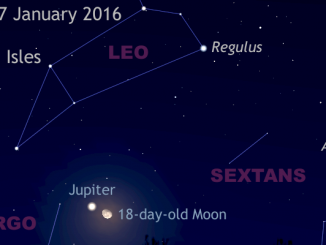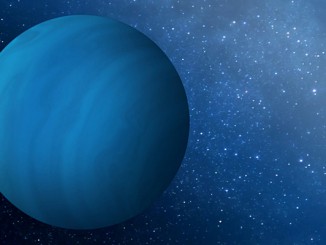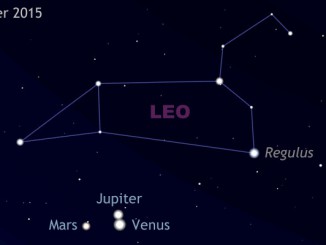
Jupiter


See the Moon’s close brush with Jupiter on the night of 27—28 January
Observers in the British Isles and western Europe with a clear sky low to the east around 10pm local time on Wednesday, 27 January can see the rising 18-day-old waning gibbous Moon in a close conjunction with Jupiter, the solar system’s largest planet. Jupiter draws steadily closer to Earth and grows in apparent size over the coming weeks.


See all five naked-eye planets gathered in the morning sky
All five of the bright naked-eye planets are observable in the pre-dawn sky from about the third week of January 2016, particularly if one lives south of the equator. But even from the UK, you can get to view the spectacle if you time it right — and the weather obliges! The last time that Mercury, Venus, Mars, Jupiter and Saturn appeared in the same sky was 11 years ago.

See the Moon meet planet Jupiter on the morning of 4 December
In the dawn twilight of Friday, 4 December observers in the British Isles and Western Europe can see the 23-day-old waning crescent Moon just 2.5 degrees (half a 10×50 binocular field of view) below largest planet Jupiter in the constellation Leo high in the southern sky. And if you have a telescope, Jupiter’s largest moon plays hide and seek.

Computer simulations explain Jupiter’s wild weather
The numerous whirlwinds covering Jupiter are caused by upward gas flows originating deep within the giant planet. This is the conclusion reached by scientists at the University of Alberta (Canada) and the Max Planck Institute for Solar Research (MPS) in Germany after extensive computer simulations. Their models also explain why the Jovian whirlwinds’ direction of rotation is opposite to storms on Earth.

See the Moon join the morning planets on 6-7 November
If you have a clear sky to the southeast an hour before sunrise on the morning of Friday, 6 November you will be greeted by a pairing of the old, waning crescent Moon with largest planet Jupiter. Then, on Saturday, 7 November, a slimmer crescent Moon joins planets Mars and Venus for an even closer triple conjunction. Have your binoculars and cameras ready!

Jupiter kicked a giant planet out of the solar system 4 billion years ago
The existence of a fifth giant gas planet at the time of the solar system’s formation — in addition to Jupiter, Saturn, Uranus and Neptune that we know of today — was first proposed in 2011. Now astrophysicists at the University of Toronto have found that a close encounter with Jupiter about four billion years ago may have resulted in the fifth giant planet’s ejection from the solar system altogether.

See Venus lap Jupiter, then Mars, in an early morning planetary race
In the remaining days of October and early into November, a fascinating series of planetary peregrinations plays out low in the East before dawn twilight gets too bright. Venus, like a sprinter on the inside lane of a running track, overtakes both Jupiter in Mars in two readily observable conjunctions set against the stellar backdrop of constellations Leo and Virgo.

See the morning planet show and Mercury at its best
In the small hours of Friday, 16 October, innermost planet Mercury reaches its greatest westerly elongation from the Sun. For those of you in the UK with a flat, unobscured eastern horizon and willing to get up an hour before sunrise, the next few days provide your best opportunity to see Mercury from the Northern Hemisphere during 2015.
